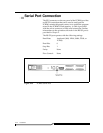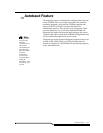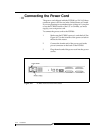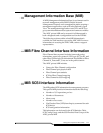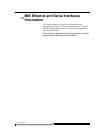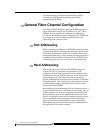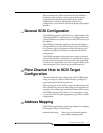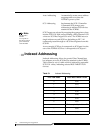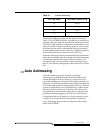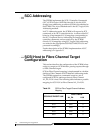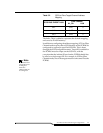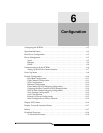
5-4 Understanding the Configuration
62-9301-01
An understanding of the basic characteristics of Fibre
Channel and SCSI devices is recommended before
configuring the FCR200.
General Fibre Channel Configuration
On a Fibre Channel arbitrated loop, the FCR200 appears at a
single Arbitrated Loop Physical Address (AL_PA). Fibre
Channel devices support two methods for obtaining an
AL_PA, these being soft or hard addressing. The FCR200 can
be configured to use soft addressing (default) or hard
addressing with a selected value.
Soft Addressing
When acquiring a soft address, the FCR200 acquires the first
available loop address starting from address 0. In this mode,
the FCR200 automatically obtains an available address and
participates on the loop, as long as there is at least one address
available on the loop that is connected to the FCR200. Fibre
Channel supports up to 126 devices on an arbitrated loop.
Hard Addressing
When acquiring a hard address, the FCR200 attempts to
acquire the AL_PA value that was specified by user
configuration. If the desired address is not available at loop
initialization time, the FCR200 comes up on the loop in non-
participating mode. This allows the loop to continue to
operate, although the unit will not be accessible via the Fibre
Channel interface. This would occur when another device on
the arbitrated loop has acquired the same address as that
configured on the FCR200.
Hard addressing is recommended for environments where it
is important that the device addresses do not change. Device
address changes can affect the mapping represented by the
host operating system to the application, and have adverse
effects. An example of such an environment would be a tape
library installation, where the application configuration
requires fixed device identification for proper operation.
Hard addressing will insure that the device identification to
the application will remain constant.



